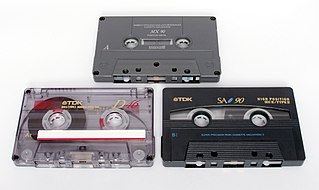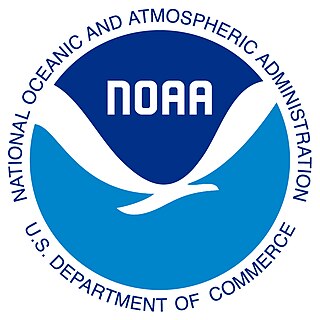Related Research Articles

Magnetic tape is a medium for magnetic storage made of a thin, magnetizable coating on a long, narrow strip of plastic film. It was developed in Germany in 1928, based on the earlier magnetic wire recording from Denmark. Devices that use magnetic tape could with relative ease record and playback audio, visual, and binary computer data.

Punched tape or perforated paper tape is a form of data storage device that consists of a long strip of paper through which small holes are punched. It was developed from and was subsequently used alongside punched cards, the difference being that the tape is continuous.

Digital Audio Tape is a signal recording and playback medium developed by Sony and introduced in 1987. In appearance it is similar to a Compact Cassette, using 3.81 mm / 0.15" magnetic tape enclosed in a protective shell, but is roughly half the size at 73 mm × 54 mm × 10.5 mm. The recording is digital rather than analog. DAT can record at sampling rates equal to, as well as higher and lower than a CD at 16 bits quantization. If a comparable digital source is copied without returning to the analogue domain, then the DAT will produce an exact clone, unlike other digital media such as Digital Compact Cassette or non-Hi-MD MiniDisc, both of which use a lossy data-reduction system.

Agricultural policy describes a set of laws relating to domestic agriculture and imports of foreign agricultural products. Governments usually implement agricultural policies with the goal of achieving a specific outcome in the domestic agricultural product markets.

Digitization is the process of converting information into a digital format. The result is the representation of an object, image, sound, document, or signal obtained by generating a series of numbers that describe a discrete set of points or samples. The result is called digital representation or, more specifically, a digital image, for the object, and digital form, for the signal. In modern practice, the digitized data is in the form of binary numbers, which facilitates processing by digital computers and other operations, but digitizing simply means "the conversion of analog source material into a numerical format"; the decimal or any other number system can be used instead.

The United States National Climatic Data Center (NCDC), previously known as the National Weather Records Center (NWRC), in Asheville, North Carolina, was the world's largest active archive of weather data. Starting as a tabulation unit in New Orleans, Louisiana in 1934, the climate records were transferred to Asheville in 1951, becoming named the National Weather Records Center (NWRC). It was later renamed the National Climatic Data Center, with relocation occurring in 1993. In 2015, it was merged with the National Geophysical Data Center (NGDC) and the National Oceanographic Data Center (NODC) into the National Centers for Environmental Information (NCEI).
Enterprise content management (ECM) extends the concept of content management by adding a timeline for each content item and, possibly, enforcing processes for its creation, approval, and distribution. Systems using ECM generally provide a secure repository for managed items, analog or digital. They also include one methods for importing content to bring manage new items, and several presentation methods to make items available for use. Although ECM content may be protected by digital rights management (DRM), it is not required. ECM is distinguished from general content management by its cognizance of the processes and procedures of the enterprise for which it is created.
Preservation of documents, pictures, recordings, digital content, etc., is a major aspect of archival science. It is also an important consideration for people who are creating time capsules, family history, historical documents, scrapbooks and family trees. Common storage media are not permanent, and there are few reliable methods of preserving documents and pictures for the future.

Microforms are scaled-down reproductions of documents, typically either films or paper, made for the purposes of transmission, storage, reading, and printing. Microform images are commonly reduced to about 4% or 1⁄25 of the original document size. For special purposes, greater optical reductions may be used.
A computer operator is a role in IT which oversees the running of computer systems, ensuring that the machines, and computers are running properly. The job of a computer operator as defined by the United States Bureau of Labor Statistics is to "monitor and control ... and respond to ... enter commands ... set controls on computer and peripheral devices. This Excludes Data Entry."
Magnetic-tape data storage is a system for storing digital information on magnetic tape using digital recording.

The Digital Revolution, also known as the Third Industrial Revolution, is the shift from mechanical and analogue electronic technologies from the Industrial Revolution towards digital electronics which began in the latter half of the 20th century, with the adoption and proliferation of digital computers and digital record-keeping, that continues to the present day. Implicitly, the term also refers to the sweeping changes brought about by digital computing and communication technologies during this period. From analogies to the Agricultural Revolution (Neolithic) and the First Industrial Revolution (1760-1840), the Digital Revolution marked the beginning of the Information Age.

Preservation of magnetic audiotape comprises techniques for handling, cleaning and storage of magnetic audiotapes in an archival repository. Multiple types of magnetic media exist but are mainly in the form of open reels or enclosed cassettes. Although digitization of materials on fragile magnetic media in library and information science is a common practice, there remains a need for conserving the actual physical magnetic tape and playback equipment as artifacts.
Oral history preservation is the field that deals with the care and upkeep of oral history materials, whatever format they may be in. Oral history is a method of historical documentation, using interviews with living survivors of the time being investigated. Oral history often touches on topics scarcely touched on by written documents, and by doing so, fills in the gaps of records that make up early historical documents.
A paperless office is a work environment in which the use of paper is eliminated or greatly reduced. This is done by converting documents and other papers into digital form, a process known as digitization. Proponents claim that "going paperless" can save money, boost productivity, save space, make documentation and information sharing easier, keep personal information more secure, and help the environment. The concept can be extended to communications outside the office as well.
The Linear Tape File System (LTFS) is a file system that allows files stored on magnetic tape to be accessed in a similar fashion to those on disk or removable flash drives. It requires both a specific format of data on the tape media and software to provide a file system interface to the data.

The term digital card can refer to a physical item, such as a memory card on a camera, or, increasingly since 2017, to the digital content hosted as a virtual card or cloud card, as a digital virtual representation of a physical card. They share a common purpose: Identity Management, Credit card, or Debit card. A non-physical digital card, unlike a Magnetic stripe card can emulate (imitate) any kind of card. Other common uses include loyalty card and health insurance card; physical driver's license and Social Security card are still mandated by some government agencies.

The National Centers for Environmental Information (NCEI) is a U.S. government agency that manages one of the world’s largest archives of atmospheric, coastal, geophysical, and oceanic data. The current director is Derek Arndt.

Nuclear famine is a hypothesized famine considered a potential threat following global or regional nuclear exchange. It is thought that even subtle cooling effects resulting from a regional nuclear exchange could have a substantial impact on agriculture production, triggering a food crisis amongst the world's survivors.

Global climate change has resulted in a wide range of impacts on the spread of infectious diseases. Like other ways in which climate change affects on human health, climate change exacerbates existing inequalities and challenges in managing infectious disease. Infectious diseases whose transmission can be impacted by climate change include dengue fever, malaria, tick-borne diseases, leishmaniasis and Ebola virus disease. For example, climate change is altering the geographic range and seasonality of the mosquito that can carry dengue.
References
- ↑ Brunet, M; Jones, P (2011-03-31). "Data rescue initiatives: bringing historical climate data into the 21st century". Climate Research. 47 (1): 29–40. doi: 10.3354/cr00960 . ISSN 0936-577X.
- 1 2 3 Brönnimann, Stefan; Brugnara, Yuri; Allan, Rob J.; Brunet, Manola; Compo, Gilbert P.; Crouthamel, Richard I.; Jones, Philip D.; Jourdain, Sylvie; Luterbacher, Jürg; Siegmund, Peter; Valente, Maria Antónia; Wilkinson, Clive W. (2018). "A roadmap to climate data rescue services". Geoscience Data Journal. 5 (1): 28–39. doi:10.1002/gdj3.56.
- 1 2 "About IEDRO". International Environmental Data Rescue Organization. Archived from the original on 18 October 2014. Retrieved 2023-04-02.
- ↑ "The Data Rescue Process". International Environmental Data Rescue Organization. Archived from the original on 18 October 2014. Retrieved 2023-04-02.